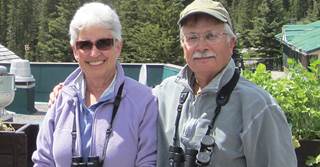A Lasting Commitment to Wetlands and Waterfowl
Major Sponsor Spotlight: John Tautin
Major Sponsor Spotlight: John Tautin
In May 1974, John Tautin began his dream job. He became a wildlife biologist for the US Fish and Wildlife Service, working to conserve migratory birds and their habitats. Three months later, he found himself on a field assignment banding ducks in Alberta, Canada, southeast of Calgary. He was a rookie, but he quickly learned that the key to successful duck banding was finding good trapping sites.
John found a promising site on private land just south of Frank Lake. As he recalls, the site was a beautiful marsh full of water, aquatic vegetation, and lots of birds. The farmer who, with some reservation, gave John permission to trap ducks saw it differently, though. To that farmer, the marsh was flooded pasture that no longer supported cattle, and, worse, it harbored ducks that ate the swathed wheat ripening in the fields.

John Tautin and his wife, Joan Galli, revisited Frank Lake while on a birding trip to Alberta.
The marsh proved to be a particularly good place for banding northern pintails. In 1975, when John returned to Alberta to band more ducks, it was the first site he checked. As he approached, looking from a distance across prairie and fields, he could see that something was different. Heavy equipment, including a dragline excavator, was working at the site. John and his banding partner drove out to investigate, fearing that the farmer was draining the beautiful marsh. With some trepidation, they asked the work crew what was going on. They were informed that, indeed, the farmer planned to drain his marsh, but they werent working for him. They were with Ducks Unlimited Canada (DUC), installing a steel weir to stabilize Frank Lake.
When John got home from his 1975 banding assignment, he joined DU. He has been a supporter of the French Creek Valley Chapter in northwestern Pennsylvania ever since. John didnt know it at the time, but DUC had worked at Frank Lake in 1952 when, during a period of flooding, they constructed a drainage ditch that secured the main lake and its basin. More work was needed during the drought of the 1980sthis time, DUC secured a long-term supply of water and constructed a series of dikes and water-control structures to maintain the lake at optimal levels.
Today, the lake and surrounding uplands are known as the Frank Lake Conservation Area and are designated as one of Canadas Important Bird Areas. John and his wife, Joan Galli, returned to Frank Lake in 2012 and can attest to its enduring value to waterfowl and other birds. Hes confident that with other members like him and Joan, DU will be caring for Frank Lake and countless other places long into the future. Wanting to create their own conservation legacy, John and Joan have included DU in their estate plans, joining thousands of others as members of the Feather Society, a special group united by their support of DU through planned gifts. From his home along Cussewago Creek in northwestern Pennsylvania, John remains active in wildlife conservation. He currently serves on the board of directors of the French Creek Valley Conservancy, one of DUs many partners in conservation.
Ducks Unlimited uses cookies to enhance your browsing experience, optimize site functionality, analyze traffic, and deliver personalized advertising through third parties. By continuing to use this site, you agree to our use of cookies. View Privacy Policy